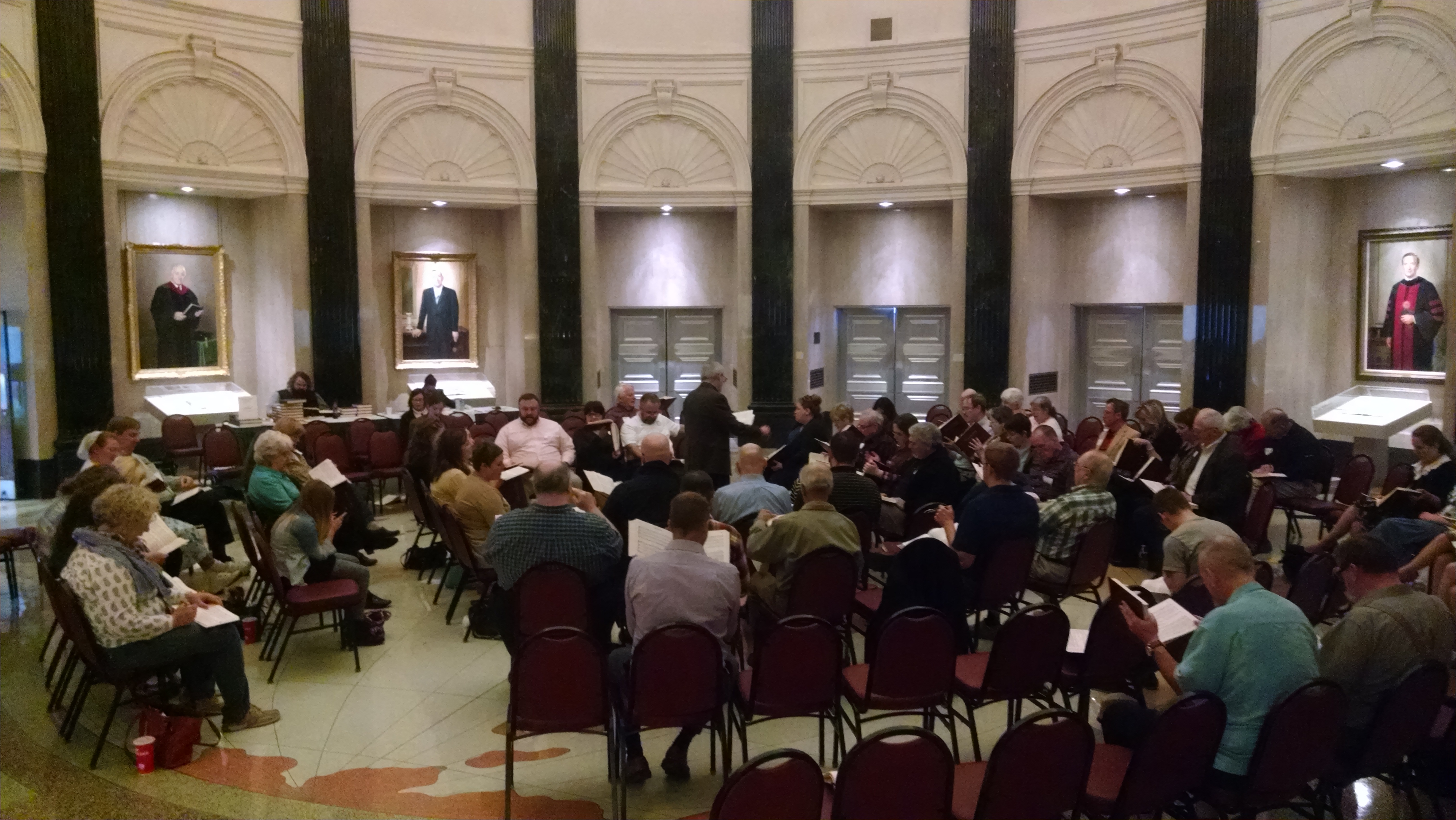Come Join In and Help Me to Sing
"Ye souls, who are bound unto Canaan, Come, join in and help me to sing"
Ascending the steps I can hear over 200 voices singing in unison, like a loud hum. Placing my hand on the door handle I can feel the vibrations of their voices. Opening the door the symphony of sound engulfs me like the waves of the ocean crashing into a rocky shoreline. I stand there for a few seconds immersed, then take my seat, open my copy of the Sacred Harp and join in.
The Sacred Harp is a song book. It was first published in Hamilton, Georgia in 1844 and compiled by B.F. White. One of the many "shape note', oblong songbooks published in the 18th and 19th century, the "Sacred Harp" refers to the human voice. Sacred Harp Music is also known as Shape Note Singing. The shape notes (Fa, So, La, Mi) are designed for people to learn music by sight reading and allow the singers to sing intricate, advanced music.
The songs are sung acapella in four sections; bass, treble, alto and tenor. The sections are divided and the singers sit in their appropriate section facing the "hollow square". Each song is led by a different leader who stands in the center of the hollow square. It's the leader's job to keep the time and rhythm of the song. Leading a song is voluntary and not mandatory, so newcomers should not feel intimidated. "Singings" are held weekly, monthly or at annual conventions.
It's also important to note that Sacred Harp singing is not a performance; there is no audience or applause after a song. The music is participatory and there are no rehearsals or auditions. All are welcome no matter one's singing ability. As the saying goes, "People may say I can't sing, but nobody will say I didn't sing."
The roots of this music can be traced back to the 18th century country parish music of England. Singers were taught to sing in syllables of do, re, mi, fa, so, la, ti. The music began to evolve into its current form in New England and spread to Pennsylvania, the Ohio Valley and down through the Appalachians to the south. Across the new born country "tune books" were printed that contained the four main parent notes that became the shape notes. The father of these tune books was William Billings.
William Billings of Boston, Massachusetts (October 7, 1746 - September 26, 1800) is recognized as America's first choral composer. Billings wrote music in a four part chorus style, to be sung acapella. His song books included The New-England Psalm-Singer (1770), The Singing Master's Assistant (1778), Music in Miniature (1779), The Psalm-Singer's Amusement (1781), The Suffolk Harmony (1786) and The Continental Harmony (1794).
The music further evolved in 1801 when William Little and William Smith published "Easy Instructor", the tune book used four distinct shape note heads; a triangle (fa), a circle (sol), a rectangle (la), and a diamond (mi). This notation was actually created by John Connelly, a Philadelphia merchant. Connelly signed over the rights to the notation to Little and Smith in March of 1798.
This was followed by William Walker in 1835 who published "The Southern Harmony and Musical Companion" in South Carolina. The book became popular with settlers moving from the Carolinas into Alabama and Georgia. Many of the songs in the Sacred Harp are copied from existing tune books including the Southern Harmony book. The Sacred Harp became the preeminent song book, as this form of singing spread across the South.
Sacred Harp music came to East Texas with the early settlers from Georgia, Alabama and other southern states. As a matter of fact one of the oldest annual Sacred Harp Conventions is the East Texas Convention. In 1855 East Texans formed the East Texas Musical Convention. That convention, now commonly known as the East Texas Convention (also known as the East Texas Sacred Harp Singing Convention), is the oldest known singing convention in Texas and the second oldest active Sacred Harp Convention in the United States.
In East Texas there are also monthly singings in Henderson, Houston, Mount Enterprise and Nacogdoches. The next annual convention, in East Texas is the 37th Annual Smith Memorial Singing in New Harmony, Texas on Saturday March 12th, 2016. It will be held at the New Harmony Community Center on FM 7214. For more information on the convention, contact Myrl Jones at (903) 5930955. For more information on Texas Sacred Harp singing please go to http://singings.texasfasola.org.
Today most Americans are consumers of the arts, rather than participants. Sacred Harp gives a person, no matter their singing ability, the opportunity to take part in an original American art form. Furthermore, although the songs are spiritual in nature no church affiliation is attached to the singing. As I was told by a Sacred Harp singer when I first started, "You are always welcomed with open arms!"

Liner Notes "Awake My Soul, Help Me To Sing" Awake Productions 426 Mathewson Place Atlanta, Georgia
http://www.georgiaencyclopedia.org/articles/arts-culture/sacred-harp
http://sacredharpdetroit.org/
"Distant Roots of Shape Note Music" by Keith Willard, fasola.org
McKay, David P. (1975). William Billings of Boston. Princeton and London: Princeton University Press. pp. 82, 85
David Warren Steel with Richard H. Hulan, The Makers of the Sacred Harp, University of Illinois Press, page 4
Easy Instructor Part II, page 2
http://www.apadrecordings.com/southarm.htm
David Warren Steel with Richard H. Hulan, The Makers of the Sacred Harp, University of Illinois Press, page 4
https://tshaonline.org/handbook/online/articles/xfe01